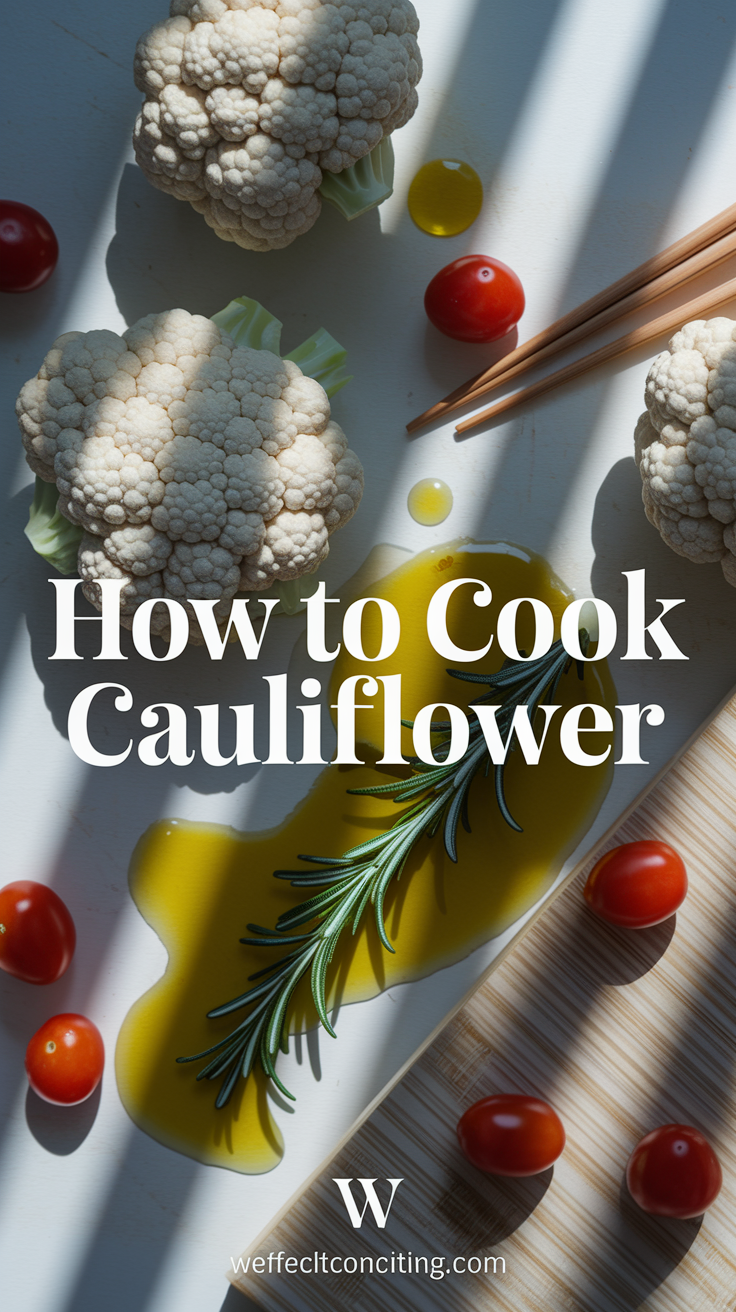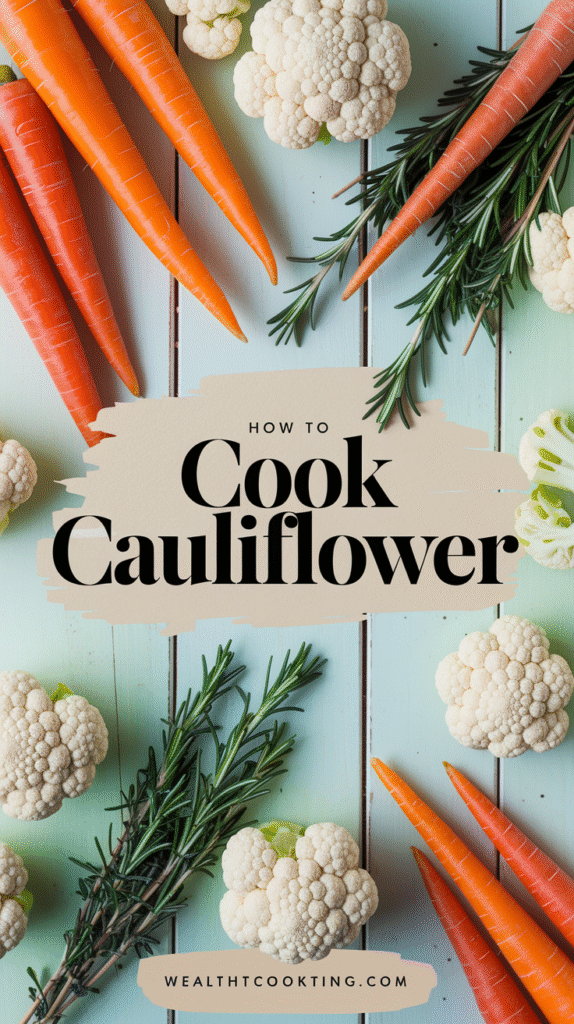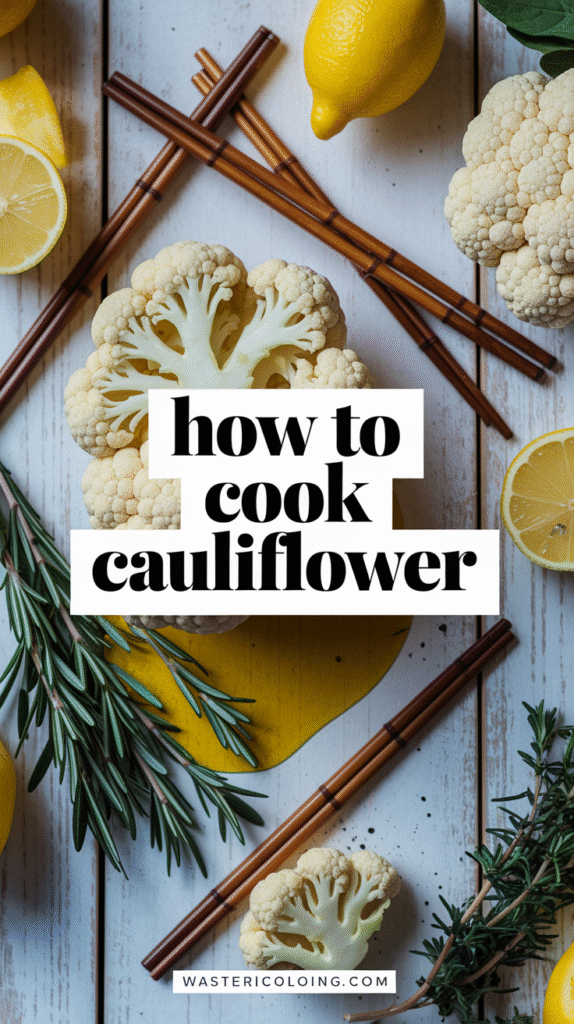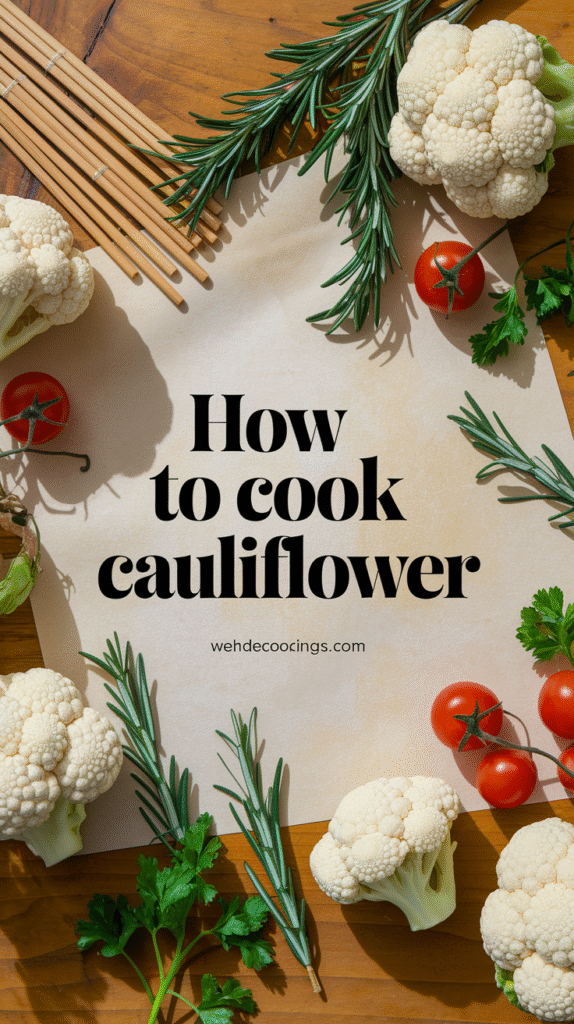Cauliflower is a versatile vegetable that can be prepared in various delicious ways. Whether you want to roast, steam, or mash it, there are countless methods to cook cauliflower, each bringing out its unique flavor. This guide will share popular techniques and helpful tips to make delicious cauliflower dishes that you can enjoy.
Choosing the Right Cauliflower
Start by selecting high-quality cauliflower. Look for a head that is firm and compact with bright white florets. Avoid any brown spots or signs of wilting. Freshness is key to achieving the best flavor and texture.
Preparing Cauliflower
Before cooking, you’ll need to prepare your cauliflower properly. Follow these steps:
- Wash the cauliflower thoroughly under cold running water to remove any dirt or bacteria.
- Remove the leaves and stem using a sharp knife.
- Cut the cauliflower into florets, ensuring they are roughly the same size for even cooking.
Cooking Methods for Cauliflower
Roasting
Roasting cauliflower is an excellent way to enhance its natural flavors. Follow these simple steps:
- Preheat your oven to 425°F (220°C).
- Toss the cauliflower florets with olive oil, salt, and pepper in a large bowl.
- Spread them out in a single layer on a baking sheet.
- Roast for 25 to 30 minutes, turning halfway through, until golden brown and tender.
For added flavor, you can sprinkle garlic powder, paprika, or parmesan cheese before roasting.
Steaming
Steaming is another healthy cooking method that preserves nutrients in cauliflower. Here’s how to do it:
- In a pot, add a couple of inches of water and bring it to a boil.
- Place the cauliflower florets in a steaming basket above the boiling water.
- Cover and steam for about 5 to 7 minutes, or until tender.
Steamed cauliflower can be a perfect side dish or a base for salads.
Mashing
If you’re looking for a low-carb alternative to mashed potatoes, cauliflower mash is the way to go. Follow these steps:
- Boil cauliflower florets in salted water for about 15 minutes until fork-tender.
- Drain and transfer to a food processor.
- Add butter, cream, salt, and pepper, then blend until smooth.
Cauliflower mash is creamy and delicious, and you can customize it by adding herbs or roasted garlic for additional flavor.
Stir-Frying
Stir-frying cauliflower allows for quick cooking while keeping its crunch. Here’s how to do it:
- Heat a wok or large skillet over medium-high heat and add oil.
- Add cauliflower florets and stir-fry for about 5-7 minutes.
- You can mix in other vegetables like bell peppers or snap peas for a colorful and healthy dish.
Season with soy sauce or sesame oil for extra taste. Serve it over rice or noodles for a balanced meal.
Useful Tips for Cooking Cauliflower
- To enhance the flavor, try seasoning your cauliflower with various spices like cumin, curry powder, or Italian herbs.
- If you want a quick cooking technique, consider blanching before the main cooking method. Blanching helps retain color and texture.
- For a unique presentation, try grilling cauliflower steaks. Just slice the head into thick pieces and grill until charred.
Cauliflower can be enjoyed in many forms, from soups to salads. It’s also a great ingredient for low-carb diets, providing a healthy alternative to grains and starches. For some inspiration and more interesting recipes, visit Food Network or Cooking Light.
Experimenting with cooking methods can reveal exciting flavors in cauliflower, making your dishes both nutritious and enjoyable. With these techniques and tips, you can confidently cook cauliflower to perfection, tailoring it to suit your personal taste.
Flavor Pairings That Enhance Cauliflower Dishes
Cauliflower is a versatile vegetable that can absorb a variety of flavors, making it a favorite among cooks and home chefs. To create delicious cauliflower dishes, it’s essential to know which flavors pair well. Here are some fantastic combinations that will elevate your meals.
Herbs and Spices
Using fresh herbs and spices can dramatically enhance the taste of cauliflower. Here are some great options:
- Garlic: Roasted, sautéed, or minced, garlic adds a rich flavor that complements the mildness of cauliflower.
- Turmeric: This spice not only gives a beautiful yellow hue but also brings a warm, earthy flavor.
- Cumin: Its warm and nutty taste pairs well with roasted cauliflower.
- Additions of Fresh Herbs: Think of basil, parsley, or cilantro for an herbaceous lift.
Cheeses
Cheese can add creaminess and a savory kick to your cauliflower dishes. Consider these pairings:
- Parmesan: Grated or melted, it provides a salty depth.
- Feta: Crumbled on top, feta adds a tangy flavor that contrasts beautifully with roasted cauliflower.
- Cheddar: A sharp cheddar can elevate cauliflower in mashed or baked forms.
Citrus Fruits
Citrus fruits can brighten your cauliflower dishes, adding acidity and a refreshing note. Try these:
- Lemon: A squeeze of fresh lemon juice or zest enhances flavor and adds brightness to steamed cauliflower.
- Orange: A bit of orange zest can complement roasted cauliflower nicely.
Other Vegetables
Combining cauliflower with other vegetables makes for a robust dish. Here are some great vegetable partners:
- Broccoli: Both vegetables cook well together and share a nice flavor profile.
- Carrots: Their sweetness balances the earthiness of cauliflower.
- Bell Peppers: Adding vibrant colors and sweetness gives a lovely contrast.
Fats and Oils
The right fats can enhance the texture of cauliflower dishes as well. Consider these:
- Olive Oil: Drizzling with high-quality olive oil promotes richness and depth of flavor.
- Butter: Adding butter to mashed cauliflower can create a creamy, rich alternative to traditional mashed potatoes.
- Coconut Oil: This oil gives a subtle sweetness, particularly well-suited for curry-flavored dishes.
Flavorful Sauces
Sauces can be game-changers when it comes to cauliflower dishes. Here are some to consider:
- Chili Sauce: Adds heat and excitement, especially for roasted or fried cauliflower.
- Ranch Dressing: For a creamy dip that turns cauliflower bites into a mouth-watering treat.
- Pesto: Combines herbs, nuts, cheese, and oil for a creamy finish.
Sweet Elements
Don’t shy away from adding a hint of sweetness to your cauliflower. Here are ideas to consider:
- Maple Syrup: A drizzle can caramelize roasted cauliflower beautifully.
- Honey: Used sparingly, honey can enhance roasted dishes, especially when paired with spicy components.
Experimenting with different flavor pairings will lead you to discover your favorite cauliflower combinations. Here are some helpful resources to explore cauliflower recipes further:
With the right flavors, you can transform simple cauliflower into a memorable dish worthy of any dinner plate. Enjoy experimenting with these combinations and discover new favorites!
Nutritional Benefits of Including Cauliflower in Your Diet
Cauliflower is a versatile vegetable that belongs to the cruciferous family, like broccoli and kale. Rich in nutrients, it can significantly enhance your diet. Let’s look at some of the key nutritional benefits of including this powerhouse vegetable in your meals.
Low in Calories but High in Nutrients
One of the most appealing aspects of cauliflower is its low caloric content. It’s an excellent choice for those looking to manage their weight without sacrificing flavor or nutrition. A one-cup serving of raw cauliflower contains about 25 calories, making it a perfect addition to various dishes.
- Calories: 25
- Protein: 2 grams
- Carbohydrates: 5 grams
- Fiber: 2 grams
- Fat: 0 grams
Packed with Vitamins and Minerals
Cauliflower is loaded with essential vitamins and minerals that your body needs to function optimally. Some of these include:
- Vitamin C: A vital antioxidant that supports the immune system and skin health.
- Vitamin K: Important for bone health and helps in blood clotting.
- Folate: Essential for DNA synthesis and repair, making it particularly important for pregnant women.
- Vitamin B6: Involved in brain health and the production of neurotransmitters.
Rich in Antioxidants
Including cauliflower in your diet can boost your antioxidant intake. Antioxidants help combat oxidative stress in the body, which can lead to chronic diseases. The sulforaphane in cauliflower has been studied for its potential cancer-fighting properties. By consuming cauliflower, you can actively support your body’s defenses.
High in Fiber
Fiber is crucial for a healthy digestive system, and cauliflower is a fantastic source. A single serving provides about 2 grams of dietary fiber, which aids in digestion and can help prevent constipation. Furthermore, a high-fiber diet can promote feelings of fullness, which might help in weight management.
Supports Heart Health
Eating cauliflower can contribute positively to heart health. The vegetable is low in cholesterol and saturated fats, making it heart-friendly. Additionally, the fiber and antioxidants present in cauliflower can help reduce inflammation, lower blood pressure, and maintain healthy cholesterol levels.
Versatile for Various Diets
Whether you’re vegetarian, vegan, or following a low-carb diet, cauliflower fits seamlessly into any meal plan. Its mild flavor allows it to absorb spices and seasonings well, making it a great base for many dishes. You can enjoy it in different forms:
- Raw: As a fresh snack or in salads.
- Steamed: To retain most nutrients and flavors.
- Roasted: For a smoky flavor with added textures.
- Pureed: As a lower-carb alternative to mashed potatoes.
Potential Health Benefits
Consuming cauliflower regularly may offer a range of health benefits, including:
- Reducing the risk of chronic diseases like heart disease and diabetes.
- Supporting weight loss efforts due to its low calorie and high fiber content.
- Enhancing skin health due to high levels of vitamins and antioxidants.
- Boosting metabolism through rich vitamin B content.
Cooking Methods to Retain Nutrients
To get the most out of cauliflower’s nutritional profile, focus on cooking methods that preserve its vitamins and minerals. Here are some of the best ways:
| Cooking Method | Nutrient Preservation |
|---|---|
| Steaming | Retains most nutrients and enhances flavor. |
| Roasting | Brings out natural sweetness while keeping nutrients intact. |
| Stir-frying | Packs flavor while minimizing nutrient loss. |
For more information on incorporating cauliflower into your meals, visit Healthline or WebMD. Both provide comprehensive insights into this nutritious vegetable.
Adding cauliflower to your plate can make a significant difference in your diet. With its myriad of health benefits, you’ll be doing your body a favor each time you include this delightful vegetable in your meals.
Creative Cauliflower Recipes for Every Meal
Cauliflower holds a unique place in the vegetable world—it’s versatile and can transform into a delightful dish for any meal of the day. Whether you’re looking for breakfast ideas, lunch inspirations, or delectable dinner options, cauliflower has your back. Below are some creative recipes that will have you cooking cauliflower in new and exciting ways.
Breakfast Delights
Start your day right with these flavorful cauliflower breakfast dishes:
- Cauliflower Hash Browns: Grate cauliflower and mix it with eggs, breadcrumbs, and seasonings. Form them into patties and sauté until golden brown. Enjoy them with your favorite dipping sauce.
- Cauliflower Smoothie: Blend steamed cauliflower with bananas, spinach, almond milk, and a scoop of peanut butter for a healthy breakfast smoothie that packs a nutrient punch.
- Cauliflower Omelet: Add finely chopped cauliflower to your egg mixture along with cheese and vegetables. Cook in a skillet for a fluffy, filling omelet.
Lunch Innovations
For lunch, elevate your meal with these satisfying cauliflower options:
- Cauliflower Rice Bowl: Pulse cauliflower florets in a food processor until they resemble rice grains. Sauté with vegetables, beans, and your choice of protein (like chicken or tofu) for a hearty bowl.
- Cauliflower Tacos: Roast cauliflower with cumin and chili powder, then stuff it in corn tortillas with avocado, salsa, and lettuce for a healthy twist on tacos.
- Cauliflower Salad: Toss roasted cauliflower with chickpeas, cherry tomatoes, cucumber, and a lemon-tahini dressing for a refreshing salad.
Dinner Creations
End your day with these scrumptious cauliflower dinner recipes:
- Buffalo Cauliflower Bites: Cauliflower florets are battered, baked, and coated in buffalo sauce. Serve with ranch or blue cheese dipping sauce for a spicy kick.
- Cauliflower Steaks: Slice a whole cauliflower into thick “steaks.” Season with olive oil, salt, and pepper, then grill or roast until tender. Serve as a side or main dish topped with chimichurri.
- Cauliflower Curry: Sauté onions, garlic, and ginger, then add chopped cauliflower and coconut milk. Simmer with curry spices for a warm, comforting dish served over rice.
Snack Time!
Who says healthy snacks can’t be delicious? Here are some cauliflower-based snacks:
- Cauliflower Popcorn: Toss small cauliflower florets with olive oil and your favorite seasonings, then roast until crispy. A great alternative to popcorn!
- Cauliflower Hummus: Blend steamed cauliflower with tahini, garlic, and lemon juice for a creamy dip that pairs perfectly with vegetables or pita chips.
- Cauliflower Pizza Crust: Mix grated cauliflower with cheese and eggs, and press it into a crust shape. Bake it, then top with your favorite pizza toppings.
Storage Tips
To enjoy your cauliflower dishes longer, here are some storage tips:
| Storage Method | Duration |
|---|---|
| Unwashed Florets | 5-7 days in refrigerator |
| Cooked Cauliflower | 3-5 days in refrigerator |
| Frozen Cauliflower | Up to 1 year in freezer |
Cauliflower is an excellent choice for anyone looking to add more vegetables to their diet without sacrificing taste. Its neutral flavor allows it to absorb a variety of spices and seasonings, making it adaptable for multiple culinary styles.
For more inspiration on creative ways to cook cauliflower, check out Love & Lemons and Food Network. Dive into these recipes, and you may find that your new favorite dish includes this humble yet extraordinary vegetable.
So, get creative in the kitchen and enjoy cooking cauliflower like never before!
Common Mistakes to Avoid When Cooking Cauliflower
Cooking cauliflower can be simple and delicious, but many people make common mistakes that can hinder the flavor and texture of this versatile vegetable. Whether you’re roasting, steaming, or ricing it, steering clear of these pitfalls will help you enjoy the best cauliflower dishes possible.
Overcooking the Cauliflower
One of the biggest mistakes when cooking cauliflower is overcooking it. Cauliflower tends to lose its vibrant color and becomes mushy when cooked for too long. To avoid this, keep an eye on the cooking time. Here are some guidelines:
- Steaming: Steam cauliflower florets for about 5-7 minutes until they are tender but still crisp.
- Boiling: If boiling, do not exceed 4-5 minutes.
- Roasting: Roast in the oven at 400°F (200°C) for around 20-25 minutes, turning halfway for even browning.
Neglecting to Season
Many cooks forget to season cauliflower adequately, which can result in bland dishes. Cauliflower has a mild flavor that benefits from bold seasoning. Consider using:
- Salt and pepper for basic seasoning
- Garlic powder or fresh minced garlic for added depth
- Cumin or curry powder for an exotic twist
- Cheese, such as Parmesan or cheddar, for a rich finish
Not Preparing the Cauliflower Properly
Proper preparation of cauliflower is crucial. Always rinse it well to remove any dirt or insects, and ensure you cut the florets evenly so they cook uniformly. Here’s a quick guide for cutting:
- Remove the leaves and stem from the cauliflower.
- Cut the head into quarters.
- Slice each quarter into uniformly-sized florets.
Ignoring Cooking Methods
Different cooking methods can yield different textures and flavors. Many people default to boiling or steaming, which can lead to bland results. Consider experimenting with these preparation methods:
- Roasting: Caramelizes the natural sugars, enhancing flavor dramatically.
- Grilling: Adds a smoky flavor, especially when brushed with olive oil.
- Ricing: Grate raw cauliflower to make a healthy alternative to rice—great in stir-fries or bowls.
Using Incorrect Equipment
The right cooking equipment matters. For example, if you’re roasting cauliflower, using a sheet pan with adequate spacing allows the florets to crisp rather than steam. Here are some useful kitchen tools:
- Baking sheets for roasting
- Steamer baskets for steaming
- Food processors for making cauliflower rice
Not Tasting While Cooking
Skipping the tasting process while cooking can lead to unbalanced flavors. It’s essential to check the seasoning and adjust as needed. Here’s how:
- After cooking, taste your cauliflower.
- Add more seasoning if necessary, such as salt or spices.
- Blend flavors by adding sauces or toppings just before serving.
Not Allowing for Rest Time
If you’re roasting cauliflower, letting it rest for a few minutes after cooking can enhance the flavor. This short break allows for the aromas to settle and the flavors to deepen. Here’s a simple resting tip:
- Remove the cauliflower from heat.
- Let it rest for 5 minutes before serving.
By avoiding these common mistakes when cooking cauliflower, you can create flavorful and satisfying dishes. Not only does this vegetable bring range and nutrition to your diet, but with the right techniques, it can truly shine on your plate.
For more insights into cooking cauliflower and to find delicious recipes, visit [Serious Eats](https://www.seriouseats.com/how-to-cook-cauliflower) or [EatingWell](https://www.eatingwell.com/recipe/261637/roasted-cauliflower/). These websites offer valuable tips to enhance your culinary skills!
Conclusion
Embracing cauliflower as a staple in your kitchen opens the door to countless culinary possibilities. By mastering various cooking techniques—from steaming and roasting to ricing and mashing—you can enjoy this versatile vegetable in numerous forms. Pairing cauliflower with complementary flavors like garlic, cheese, and herbs can elevate your dishes, making them more exciting and satisfying.
Cauliflower into your diet not only introduces delicious options but also provides significant nutritional benefits. Rich in vitamins, antioxidants, and fiber, this powerhouse vegetable supports overall health, aids in digestion, and promotes weight management. Whether you’re striving for a hearty meal or a light snack, there is a creative cauliflower recipe for every occasion—be it a comforting cauliflower soup, flavorful cauliflower tacos, or crispy cauliflower bites.
However, it’s crucial to be mindful of common mistakes that can undermine your efforts. Overcooking this delicate vegetable can spoil its texture and flavor, while neglecting proper seasoning can leave your dishes bland. By applying the insights and tips shared in this article, you can enhance your cooking skills and make cauliflower an enjoyable part of your meals.
Remember, the journey of cooking cauliflower is not just about the final dish, but also about experimenting and discovering what works best for your taste. Whether you’re a seasoned cook or just starting out, the versatility of cauliflower is sure to delight your palate and your well-being. So, get creative and explore the vibrant world of cauliflower—you might just find a new favorite dish!







Leave a Reply